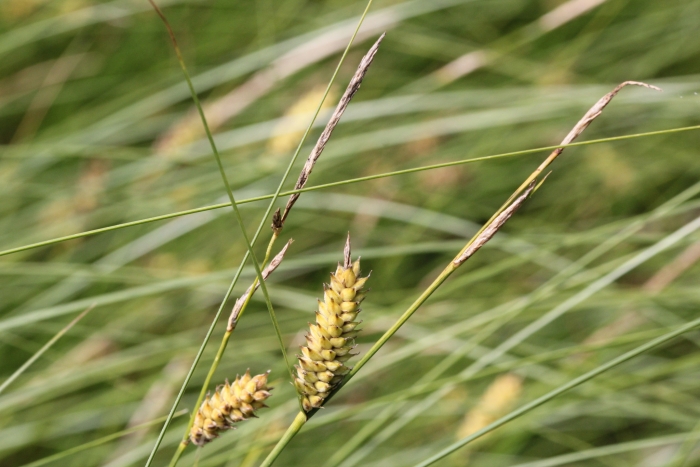Woollyfruit Sedge
(Carex lasiocarpa)
Woollyfruit Sedge (Carex lasiocarpa)
/
/

Quinten Wiegersma
CC BY 4.0
Image By:
Quinten Wiegersma
Recorded By:
Copyright:
CC BY 4.0
Copyright Notice:
Photo by: Quinten Wiegersma | License Type: CC BY 4.0 | License URL: http://creativecommons.org/licenses/by/4.0/ | Rights Holder: Quinten Wiegersma | Publisher: iNaturalist | Date Created: 2021-07-11T13:20:27-07:00 |





















Estimated Native Range
Summary
Carex lasiocarpa, commonly known as woollyfruit sedge or slender sedge, is a perennial herb native to peatlands, including bogs, fens, and shorelines across North America, Europe, and Asia. It is particularly associated with calcareous fens, which are alkaline, mineral-rich wetlands. In New York state, it is an indicator species for fens, signifying a healthy wetland ecosystem. Woollyfruit sedge typically forms dense, tussock-like clumps with erect, triangular stems that can exceed 3 feet in height. The plant’s long, narrow leaves are accompanied by compact, brownish pistillate spikes that appear in the summer. The inflorescences are not particularly showy, but they do add a subtle texture to the wetland landscape.
Woollyfruit sedge is valued for its role in wetland ecology, providing habitat and stabilizing wet soil. It is used in restoration projects to reestablish native wetland plant communities and can be planted along pond edges in garden settings. This sedge thrives in full sun to part shade, requires consistently moist to wet soil conditions, and can tolerate poor nutrient availability. It is not commonly affected by diseases or pests, but it can be sensitive to water pollution and changes in water levels. Woollyfruit sedge is not known for being invasive but should be managed to prevent it from dominating smaller, less competitive species in a garden setting.CC BY-SA 4.0
Woollyfruit sedge is valued for its role in wetland ecology, providing habitat and stabilizing wet soil. It is used in restoration projects to reestablish native wetland plant communities and can be planted along pond edges in garden settings. This sedge thrives in full sun to part shade, requires consistently moist to wet soil conditions, and can tolerate poor nutrient availability. It is not commonly affected by diseases or pests, but it can be sensitive to water pollution and changes in water levels. Woollyfruit sedge is not known for being invasive but should be managed to prevent it from dominating smaller, less competitive species in a garden setting.CC BY-SA 4.0
Plant Description
- Plant Type: Grass
- Height: 1.5-3 feet
- Width: 1-2 feet
- Growth Rate: Moderate
- Flower Color: N/A
- Flowering Season: Summer
- Leaf Retention: Semi-deciduous
Growth Requirements
- Sun: Full Sun, Part Shade, Full Shade
- Water: High
- Drainage: Slow, Standing
Common Uses
Border Plant, Erosion Control, Low Maintenance, Water Garden
Natural Habitat
Native to peatlands, including bogs, fens, and shorelines across North America, Europe, and Asia, particularly associated with calcareous fens
Other Names
Common Names: Woolly-Fruit Sedge, Hairy-Fruit Sedge
Scientific Names: , Carex lasiocarpa, Carex filiformis, Carex fuscata, Carex languinosa,
GBIF Accepted Name: